Breaking down a turkey into individual parts is not only more affordable than buying the parts separately, but it’s a great method for roasting turkey. Roasting a whole turkey broken down into parts encourages even cooking and allows you to cook each piece to it’s ideal internal temperature.
Roasting a whole turkey often leads to uneven cooking, with overdone breast meat and undercooked dark meat. Breaking down the turkey before roasting helps ensure even doneness and juicier meat all around. This simple process of cutting a turkey into parts allows you to roast each section perfectly. Read on to learn how to properly break down a turkey into wings, legs, thighs and breast.
Why Break Down a Turkey?
There are several key benefits to breaking down a turkey instead of roasting it whole:
-
Faster cooking time – Parts roast much quicker than a 15 lb whole bird The breast may be done in under an hour versus 4+ hours for an intact turkey
-
Evener doneness – When kept whole the breast overcooks while the thighs remain underdone. Breaking it down lets you roast dark and white meat to ideal temps.
-
Better crisping – The skin on a whole turkey can’t crisp up well since areas are stacked on top of each other, Separating the parts means all the skin gets direct heat contact
-
Improved seasoning – Spices and herbs flavor the meat more when rubbed directly onto parts versus just coating the outside of a whole bird.
-
Lower oven temperature – Parts can cook at 350°F versus needing 450°F+ to roast a whole turkey. This can free up oven space for side dishes.
-
Easier carving – Carving cooked parts is much simpler compared to wrestling a large hot whole turkey to slice meat.
-
More options – Turkey parts can be repurposed into numerous dishes like pot pies, sandwiches, tacos, soups etc.
What You’ll Need
Breaking down a turkey isn’t difficult, but having the right tools makes the job easier:
- Sharp chef’s knife or boning knife
- Sturdy kitchen shears
- Large cutting board
- Paper towels
- Optional: Meat mallet or tenderizer
Make sure to use a quality, sharp knife for clean cuts through joints. Kitchen shears also help snip through cartilage and bone.
How to Break Down a Turkey
Follow these simple steps to properly break down a whole turkey into parts:
Remove the legs
- Place the turkey breast side up on a cutting board. Remove any giblets or neck from the cavity.
- Pull one leg away from the body to expose the thigh joint.
- Cut through the skin between the thigh and breast.
- Continue cutting meat away from the carcass, then pop the leg out of the hip socket.
- Cut through the joint to fully detach the leg quarter.
- Repeat steps with the other leg. Set legs aside.
Remove the wings
- Slice into the wing joint where it meets the breast.
- Cut down through the joint, separating the whole wing from the turkey.
- Repeat to detach the other wing. Set wings aside with legs.
Remove the backbone
- Flip the turkey over so breast side is down.
- With kitchen shears, cut along either side of backbone to remove it.
- Alternatively, use a chef’s knife to slice the backbone away.
- Reserve the backbone for making stock.
Split the breast
- Flip turkey over so breast is up.
- Using a sturdy knife, cut along one side of the breastbone.
- Repeat on the other side to detach the bone, splitting the breast in half.
- You can leave the breast whole if preferred.
Pound the breast
- Place breast pieces between sheets of plastic wrap.
- Use a meat mallet or tenderizer to gently pound the meat to a more even thickness.
- This helps the breast cook faster and more evenly.
Season the parts
- Make a dry brine using salt, sugar, herbs and spices.
- Generously season the wings, legs, thighs and breast pieces on all sides.
- Refrigerate 30 mins up to overnight to allow brine to penetrate meat.
And that’s it! The turkey is now broken down into parts for quick, even roasting.
Roasting Broken Down Turkey Parts
Once separated, roast the seasoned turkey parts at a high temp to crisp the skin, then finish cooking at a lower temp:
- Place wings, legs, thighs and breast pieces on a rimmed baking sheet.
- Roast at 450°F for 30 minutes to initially brown the skin.
- Reduce oven to 325°F and continue roasting approximately 15-30 minutes more until done.
The breast should reach 160°F while the thighs and legs should hit 175°F when finished cooking. Smaller white meat parts may be done sooner than the larger dark meat pieces.
Let the roasted parts rest 10-15 minutes before serving for juicier meat.
Turkey Breakdown Tips
- Use paper towels to grip slippery raw turkey when cutting.
- Save scraps like the backbone and neck to make turkey stock.
- Brine legs and wings longer since dark meat benefits more from salting.
- Cook thighs and drumsticks in roasting pan with breast pieces to flavor drippings.
- Add broth or water to the bottom of the pan to keep turkey meat moist.
- Baste parts with pan juices every 20 minutes while roasting.
- Tent turkey loosely with foil as it rests to keep it warm before serving.
Why Breaking Down Turkey Is Better
While it may seem like extra work upfront, taking the time to break down a turkey leads to much tastier results:
- White and dark meat cook evenly, instead of over and underdone.
- Skin gets deliciously crispy all over.
- Seasonings deeply flavor the meat when directly applied.
- Parts can be repurposed into various dishes.
- Smaller cuts cook faster, freeing up oven space.
- Leftovers are reduced since you cook only what’s needed.
For your next turkey dinner, try breaking down the bird first for phenomenally juicy, flavorful results all around. This simple but effective technique helps you achieve the perfect roast turkey.

Separate Thighs from Drumsticks
This is an optional step, but if you want all individual cuts, you’ll need to separate the thighs from the drumsticks. Slice into thighs and drumsticks by cutting through joints at top of drumsticks.
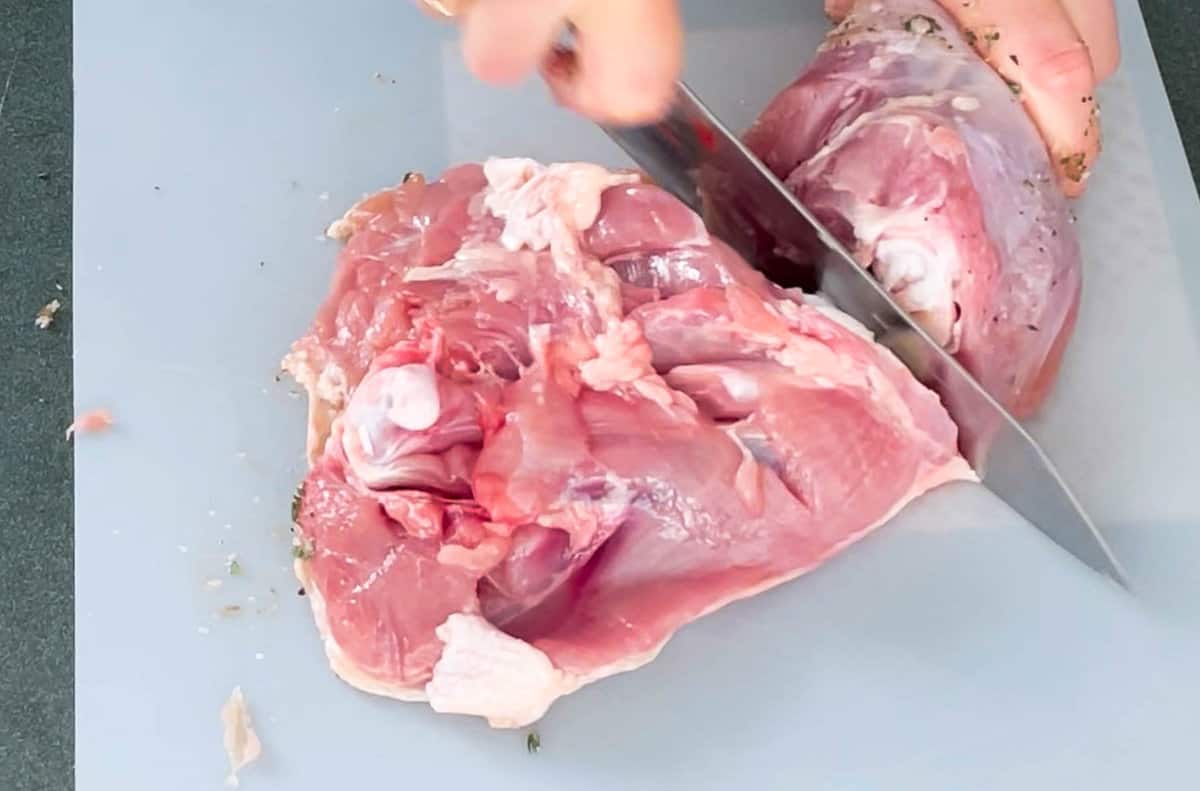
You can roast a breast with the backbone attached , but we like to remove it and use it for stocks.
To remove the backbone, cut down the inside of the backbone until the knife hits the neck bone. Pull bakbone outward until the neck pops out of the joint. Cut around the joint to release the backbone (reserve for stock).
Alternatively, you can use kitchen shears to cut down the sides of the rib cage.
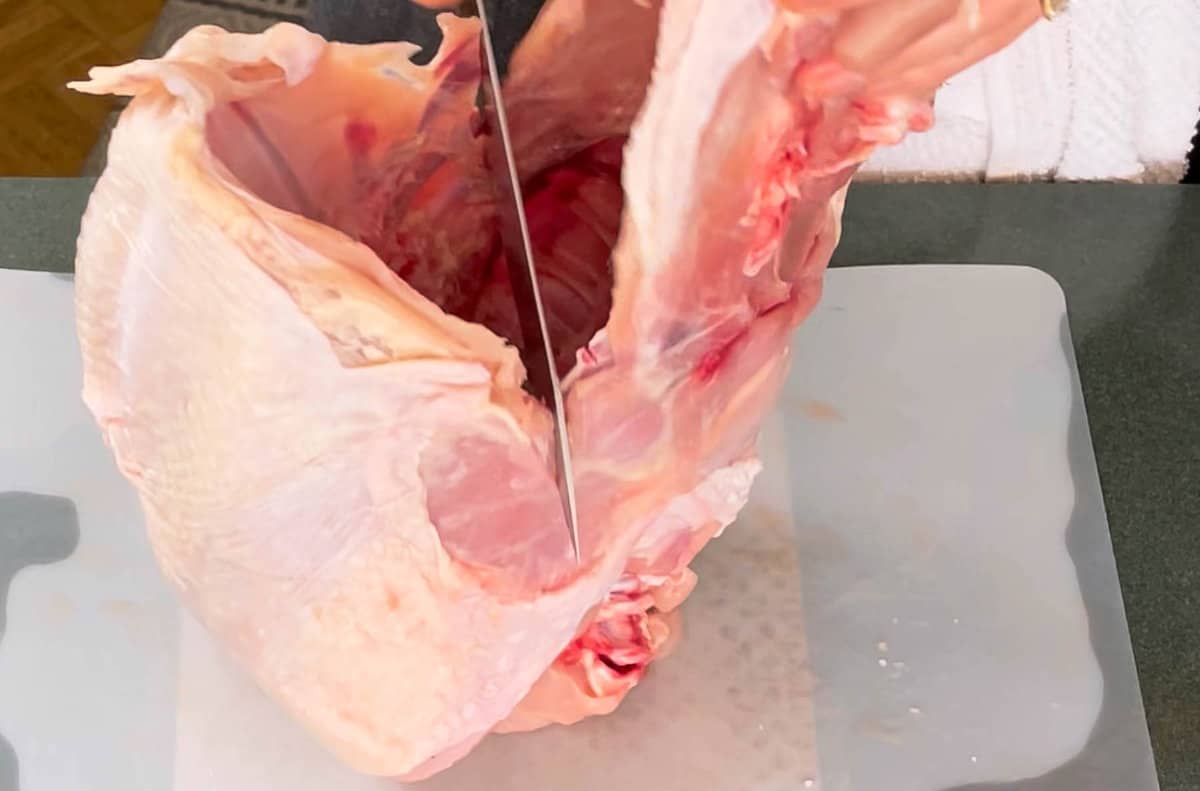
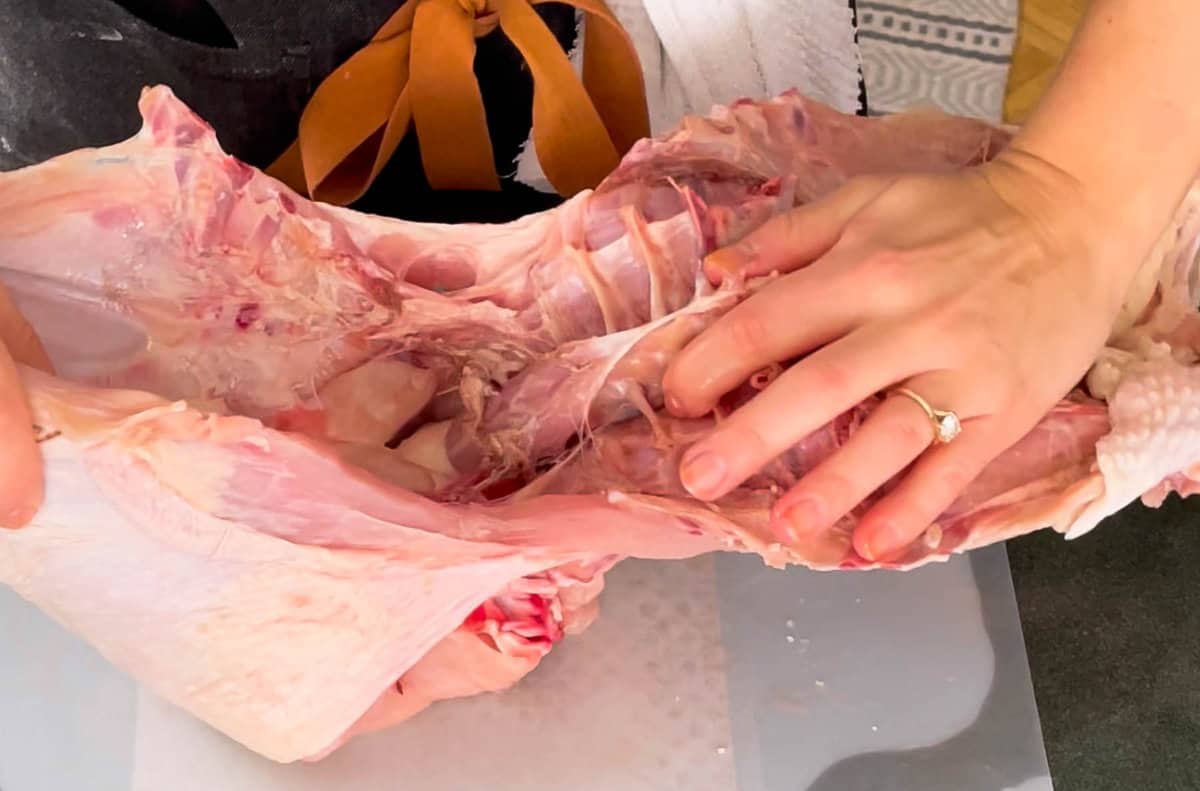
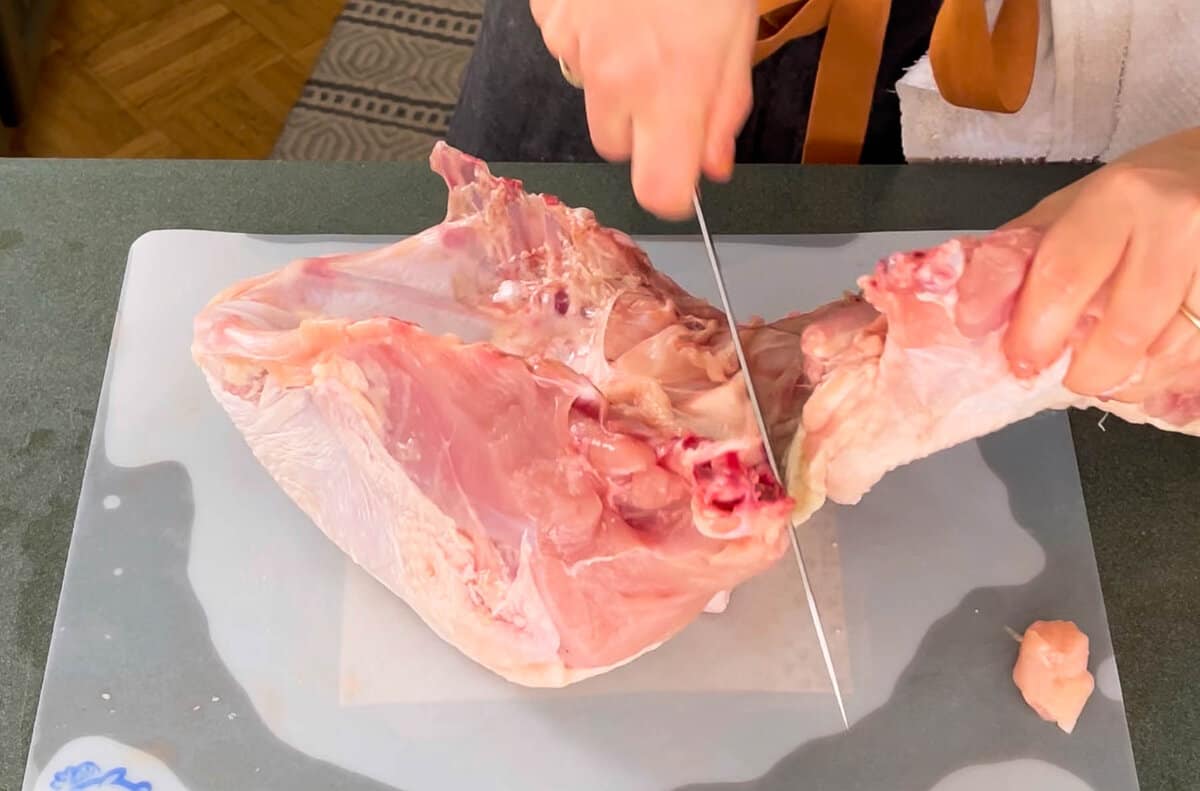
Place turkey breast-side up; cut along both sides of the breastbone, then cut and pull breast meat away from the keel bone (the plastic-like piece of cartilage). Remove and discard keel bone (or reserve for stock).
At this point, you can remove the turkey tenderloin from the breast. You can identify it by the thin white tendon running through the piece of meat. We generally keep the tenderloin attached to the breast.
In either case, we recommend removing the tendon from the tenderloin. To do so, get a firm grip on the small white end of the tendon and run your knife down alongside both sides, scraping it away and out of the turkey meat.
Arrange turkey pieces, skin side up, on wire rack set inside sheet pan.
We’ve got a great roast turkey breast recipe if you’d prefer to roast a bone-in breast. We use this recipe when we’re just roasting just the turkey breast.
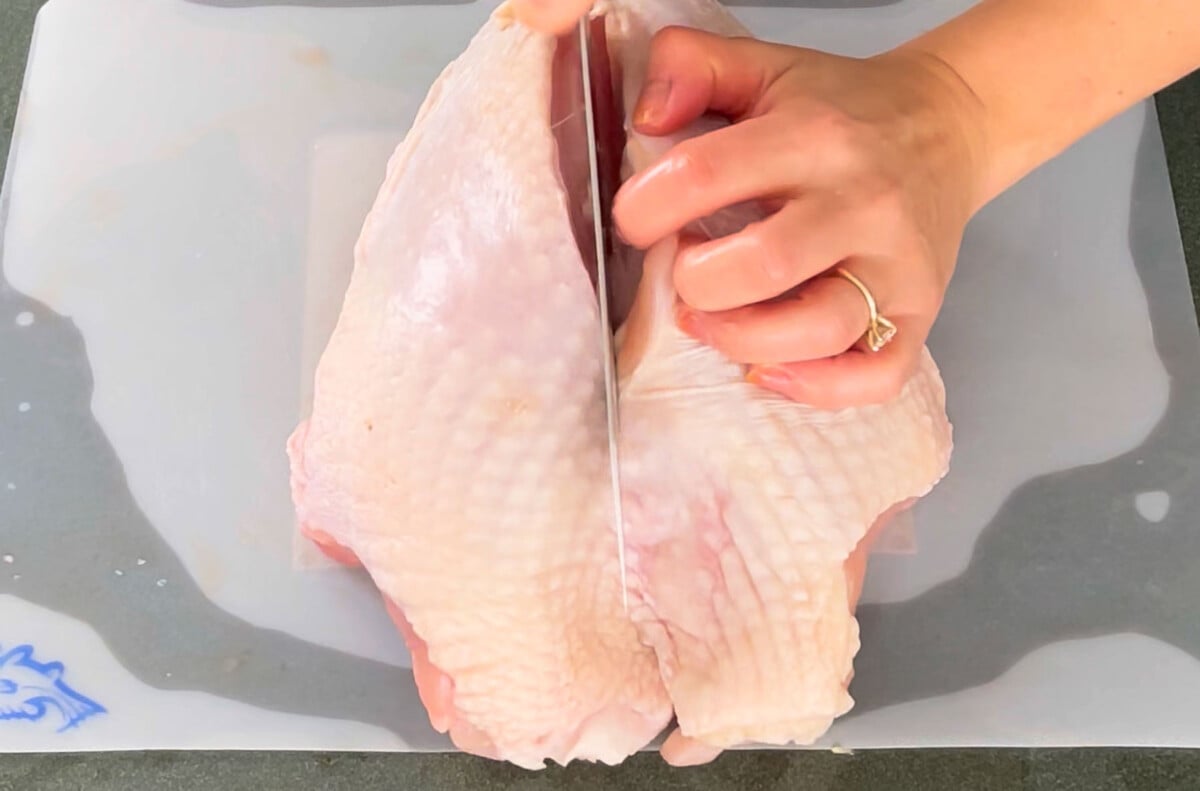
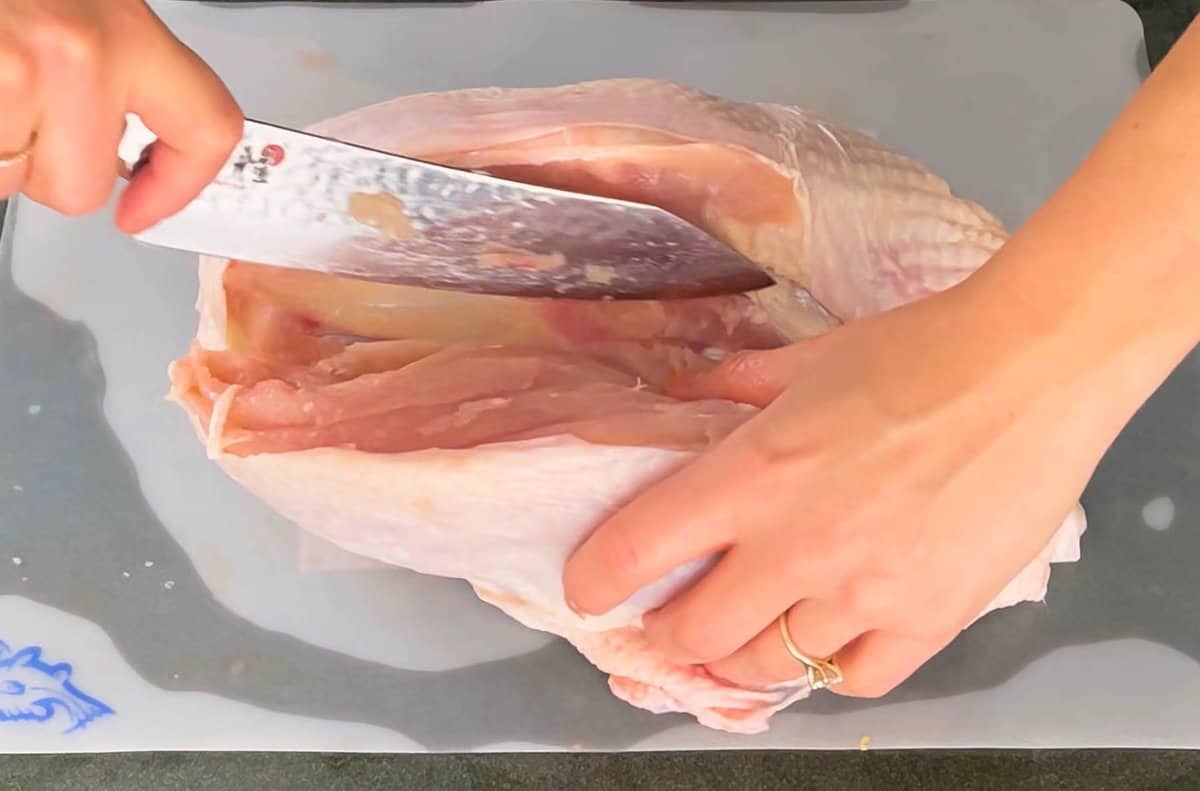
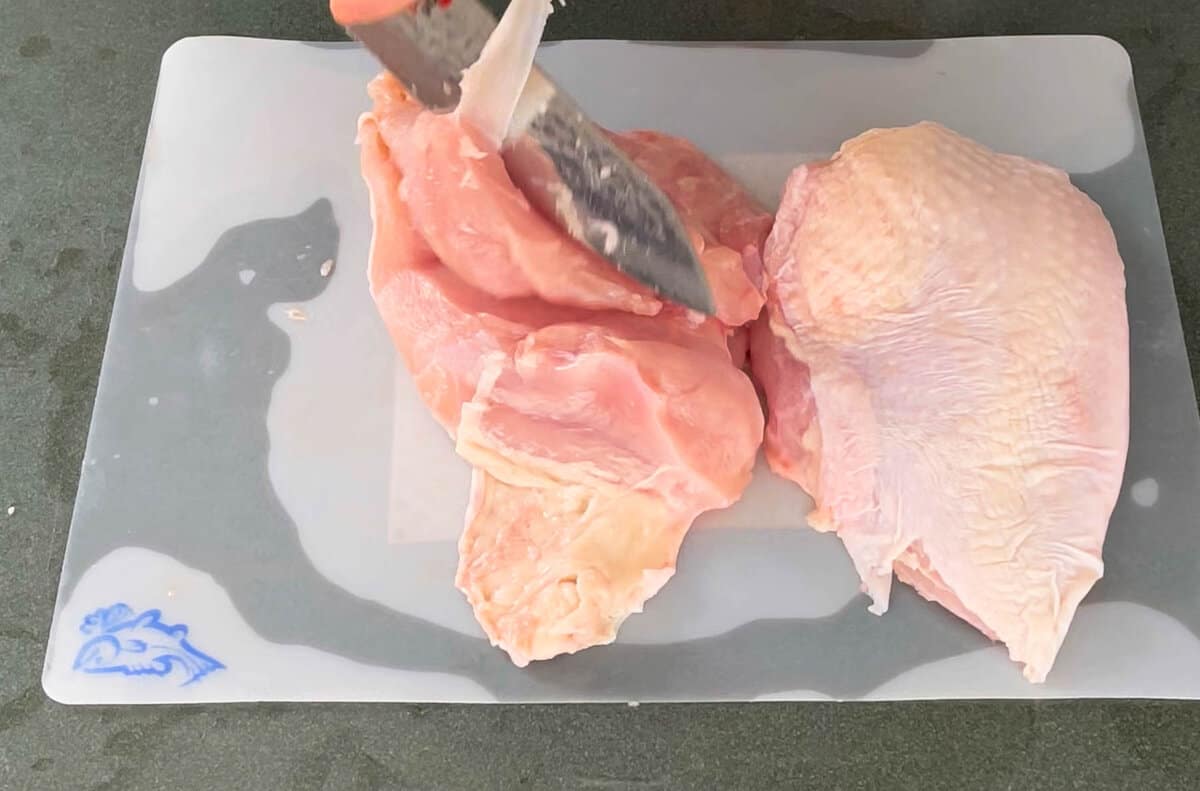
- If at any point (aside from the ribs when removing the backbone) you are hitting a bone, stop and readjust. Don’t try to cut through bone (unless you have a sharp cleaver and don’t care about finesse). There IS a way to get around the bones by cutting through the joints. Use your hands to get in there and feel around—you’ll eventually find a path forward.
- Save any bits and bobs from the carcass (large and small) to make homemade turkey stock. We even use the neck. Once the stock is done, use it in gravy or leftover turkey soup.
Why Break Down a Turkey
Breaking down a turkey into individual parts does three things. First, it makes for a much shorter cooking time. Second, it gives you control over how long each section of the turkey is cooked. When the breast meat is done, pull it out of the oven so the dark meat and cook to it’s ideal temperature. And three, it makes carving the turkey after roasting so much easier.
We love using this method of breaking down a turkey and roasting turkey parts for Thanksgiving. It requires less time, less space in the oven and you can guarantee each bite of meat—both white meat and dark meat—is cooked perfectly.

You don’t need much to break down a turkey at home, but there are a few essentials:
- A very sharp knife. You can use a boning knife or a chefs knife—use whichever knife is sharpest in your kitchen.
- Paper towels are a must. Not only will you use them to pat the turkey dry, but you can also use a paper towel as a grib for steadying the slippery bird while cutting.
- A large plastic cutting board that you use only for cutting raw meat on. Do not cut raw meat on a wood cutting board—unless you use that board for only raw meat. Make sure it’s a large cutting board!
- We recommend having an instant-read thermometer on hand for cooking. It’s essential for temping all parts of the turkey.
Make sure you are working with a raw and thawed bird. Do not attempt this if the bird is frozen or partially frozen. Allow for 1 day of thawing in the refrigerator for every 4 pounds of weight. This means a 12-pound turkey will take about 3 days to thaw fully in the refrigerator.
Remove the neck and the giblets from inside the turkey cavity. Reserve for making homemade stock. Neck can most often be reached through the top opening. Giblets will be in a small bag accessible from the back opening.
Pat turkey dry with paper towels—this will make it easier to handle the bride.
To remove the turkey wings, flex one of the wings forward and run a knife between the wing joint and breast. Make small sweeping cuts until wing releases. If you hit bone, stop and reposition the wing. Pull it out a bit farther so you can cut where the joint meets the socket.
Repeat with the second wing.
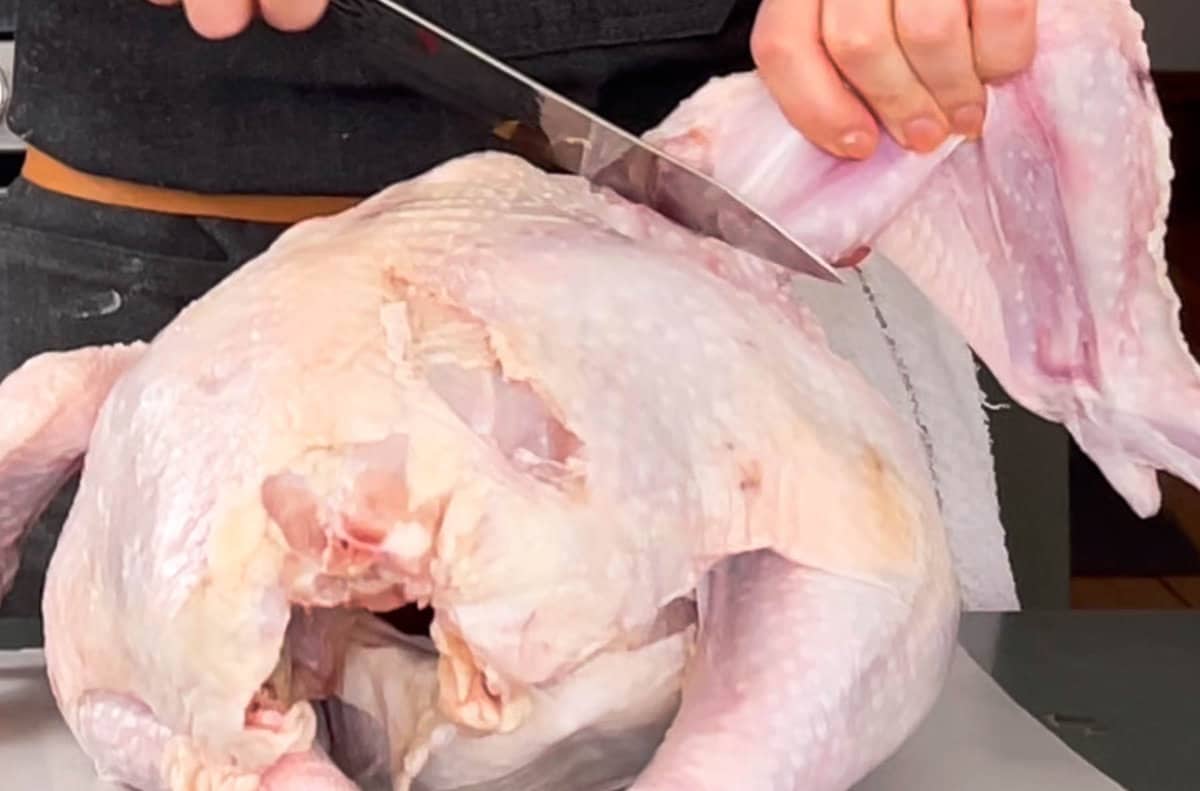
Loosen legs by stretching them out. Press the skin into the leg crease to ensure skin covers the breast. Cut alongside the leg to slice through the skin and expose the connection between the leg and the breast.
Repeat with the second turkey leg.
Bend legs backwards until the ball joint pops out of socket (you should hear some popping). Cut up along the backbone, through joint socket and release the legs from the body.
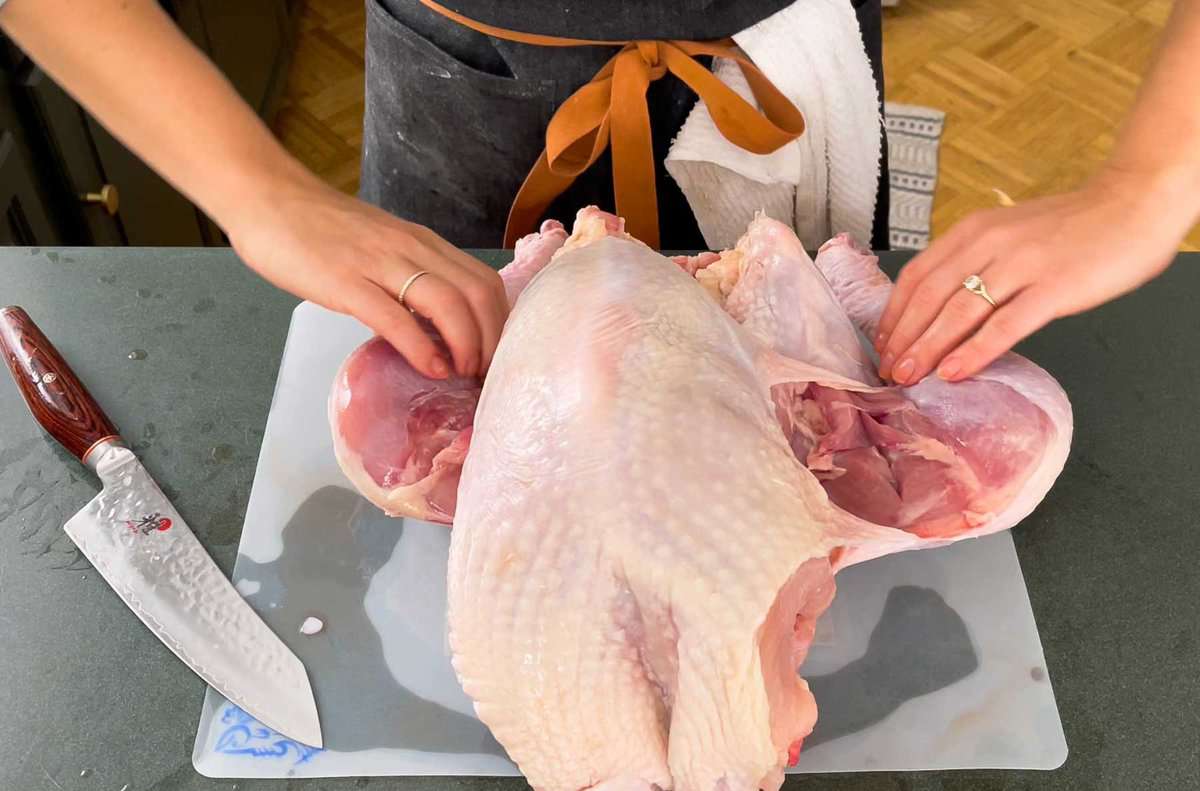
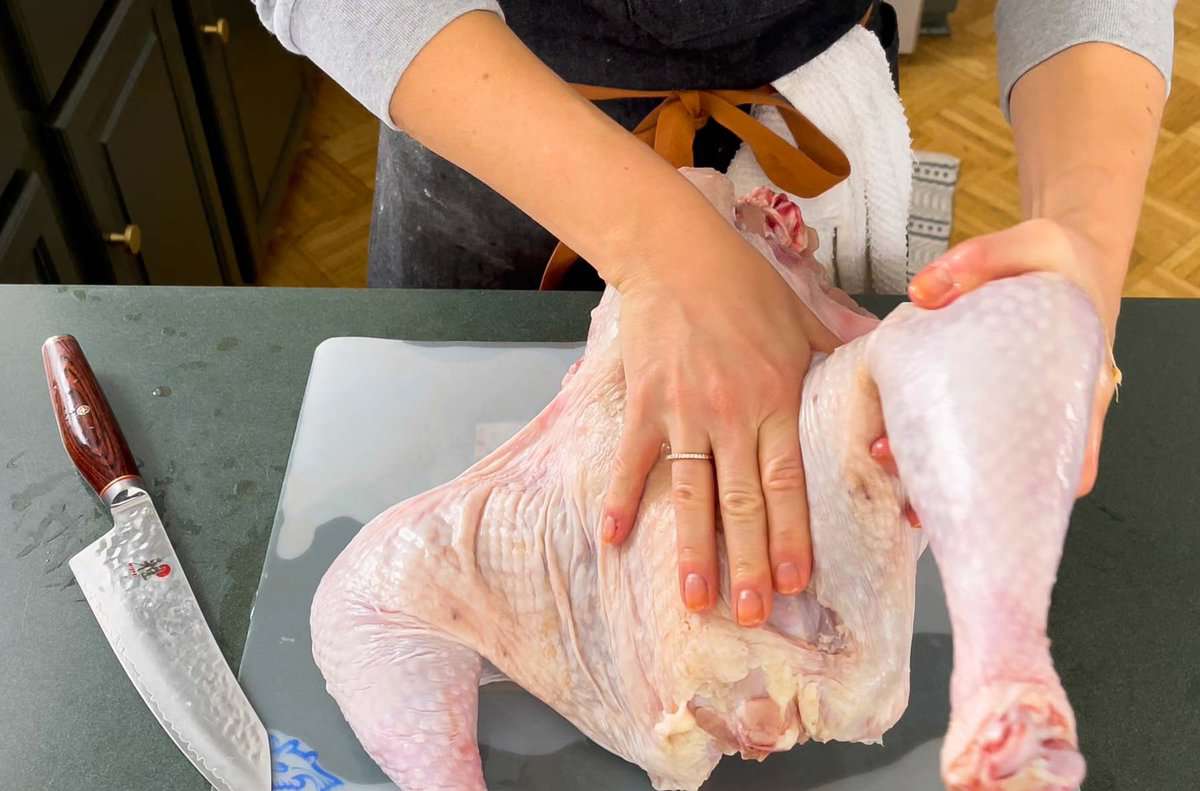
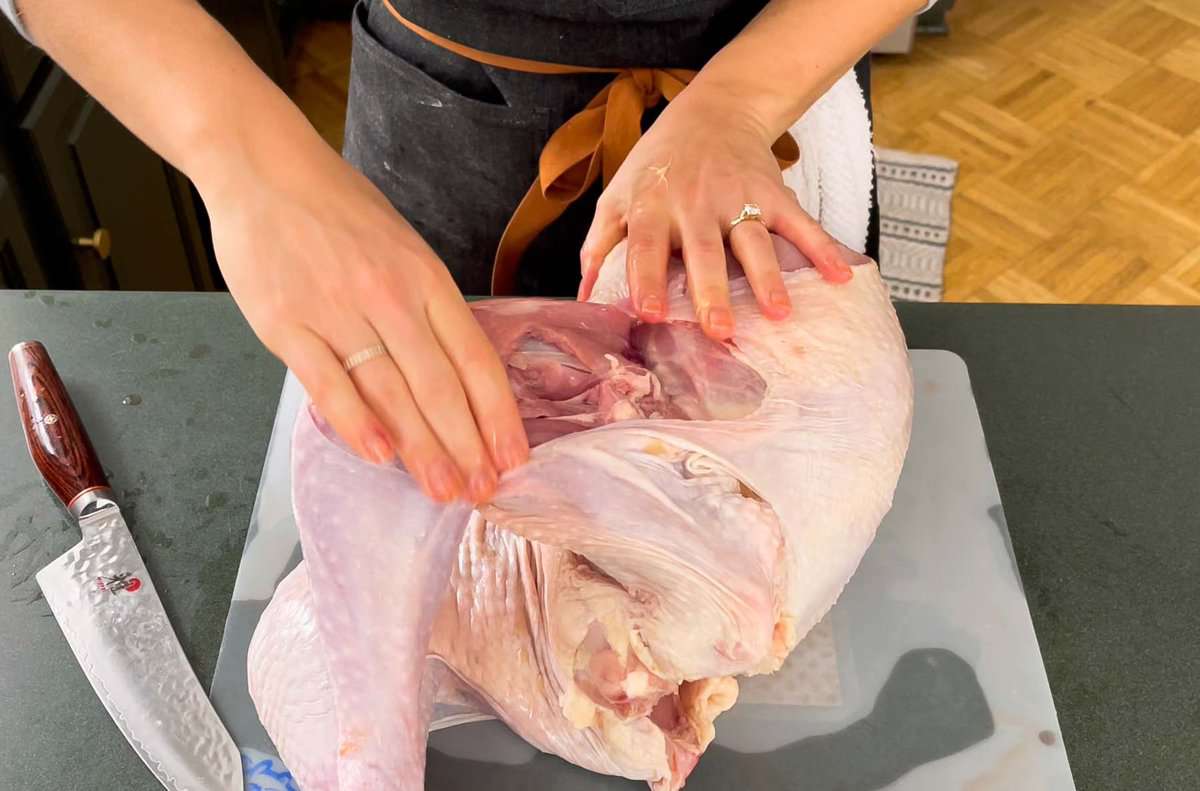
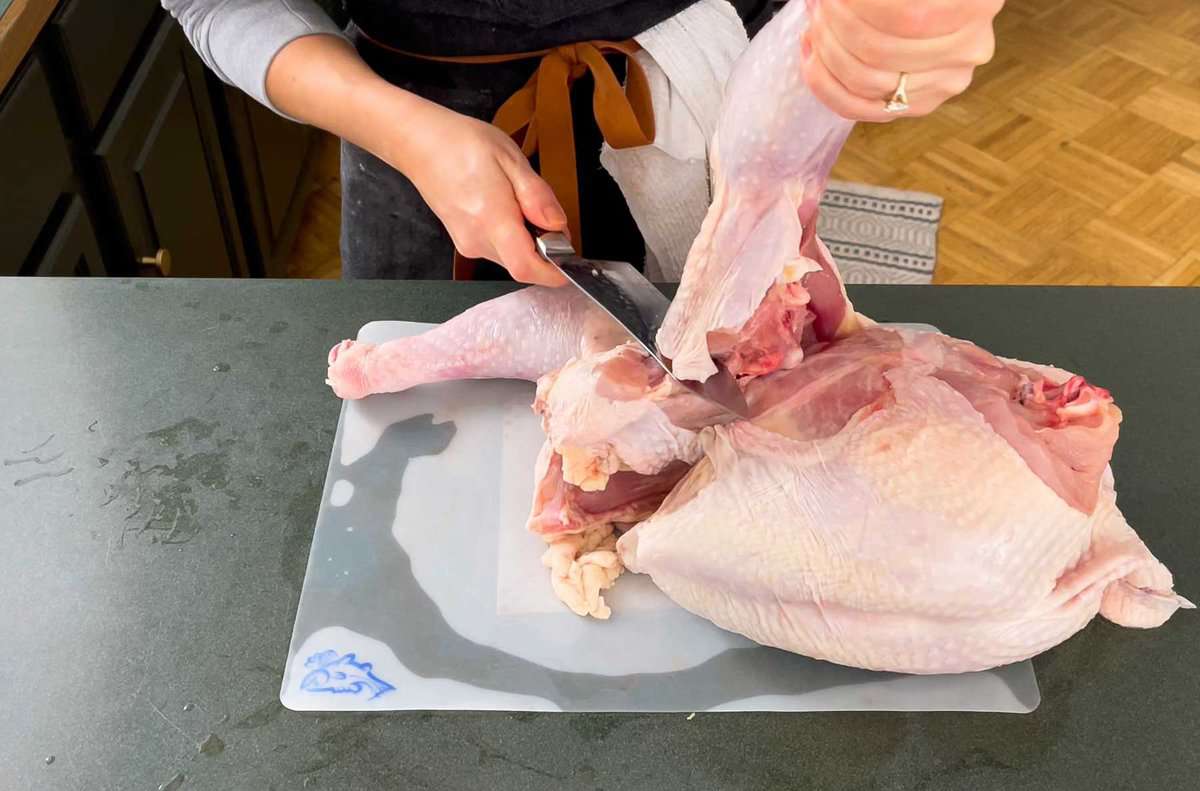
Breaking Down a Whole Turkey
FAQ
Is it worth spatchcocking a turkey?
Spatchcocking turkey cooks more evenly and more quickly than non-butterflied versions, for stunningly crisp skin and perfectly cooked white and dark meat.
How do you break apart ground turkey?
A spatula, spoon, potato masher or dough scraper can all be used to cut the meat into small crumble-sized pieces.Jun 30, 2020
How to slaughter a turkey at home?
- Restraining the turkey – cut one corner of a feed bag, making a small hole that only the head can fit through. …
- KIlling the turkey – Gently but quickly lay the head on the butcher block and swiftly cuts off the head with a very sharp hatchet.
Should you break down a turkey into parts?
Breaking down a turkey into individual parts is not only more affordable than buying the parts separately, but it’s a great method for roasting turkey. Roasting a whole turkey broken down into parts encourages even cooking and allows you to cook each piece to it’s ideal internal temperature.
How do you break down a Turkey at home?
You don’t need much to break down a turkey at home, but there are a few essentials: A very sharp knife. You can use a boning knife or a chefs knife—use whichever knife is sharpest in your kitchen. Paper towels are a must.
Should you roast a broken-down Turkey in parts?
Roasting a broken-down turkey in parts has distinct benefits over roasting a whole bird. When I say ‘in parts’, I mean breaking it down into legs, wings, and a bone-in breast, and roasting these on a large rimmed baking sheet.
